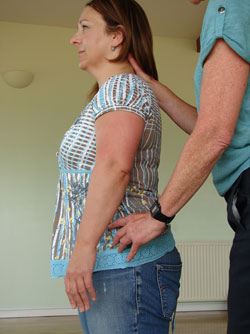Hands on guidance
 Teachers are specialists in the way people ‘use’ their body – and their whole self in any activity. They are experts in using their hands to communicate small changes to your ‘use’ that effectively make a big difference. The touch of an Alexander teacher feels comfortable. It alters the feelings of tension and seems to make a pupil feel more connected and whole.
Teachers are specialists in the way people ‘use’ their body – and their whole self in any activity. They are experts in using their hands to communicate small changes to your ‘use’ that effectively make a big difference. The touch of an Alexander teacher feels comfortable. It alters the feelings of tension and seems to make a pupil feel more connected and whole.
Habits and change
The big obstacle to change is habit. But we are lost if we cannot rely on doing things habitually. Without habit we would have to think each time we took a step, and driving a car would be perilous!
Some habits of effort and tension, we no longer need, and are actually harmful. But when it comes to changing or eliminating an unhelpful habit, then we need the help of the Alexander Technique. For example if we experience persistent stress, getting too many injuries, under–breathing and over–slumping.
Are there exercises?
Many ‘body work’ approaches to self-improvement tell you what and how to do things, with a series of exercises to practice.
However learning the Alexander Technique involves ‘mind and body work’, with an emphasis on thinking and not doing. Thinking is in fact one of the tools of the neuromuscular system.
Instead of special exercises in each lesson, you use standing, sitting, lying, bending, walking and activities from your daily life.
The semi-supine lying down practice is the only ‘exercise’ you will be asked to practice at home.
The way you ‘use’ yourself
In your nervous system you are constantly sending thousands of impulses or thoughts to your muscles in order to function, move and so on. Muscles can respond by contracting or not contracting, that is, the muscles either shorten or return to their natural length. Unfortunately many develop a greater degree of habitual contraction and shortening throughout their body.
Developing skill
The Alexander Technique involves restoring the thinking that causes muscles to lengthen and release. With skill you can avoid those old habits of tension that you were so used to.
Thoughts as messages
A good example of everyday thinking is when you subconsciously send a thought or message to allow your arm to put down your drink! This is actually your thought that has allowed the arm muscles to release. The opposite happens when someone has suffered a stroke so that their damaged nervous system does not convey the thought and they cannot lower their arm easily.
‘Inhibiting’
Our ability to release is as important as our ability to contract our musculature. This natural skill in human beings, in our present day culture goes unappreciated, under-used and weakened. In Neurology and in the Alexander Technique this skill is termed ‘inhibition’.
This calm component of living seems to get lost amongst the myriad choices of activity and excitement. Given our human tendency to become over stressed, the skill of inhibition is invaluable.
‘Directing’
We get caught up in all sorts of things, often neglecting the person who is instrumental in our whole life – ourself.
Learning the Alexander Technique enables us to consciously ‘direct’ ourselves, and so take charge of many more aspects of our life than we had thought possible.